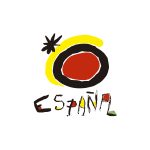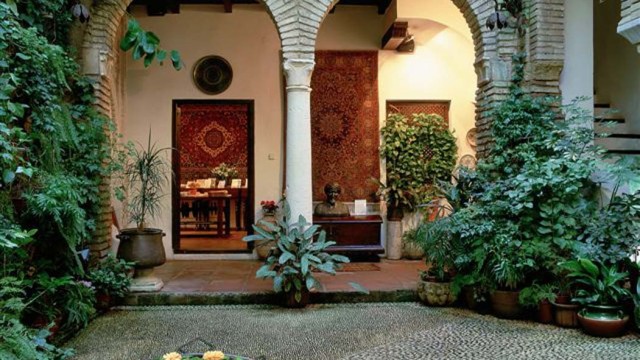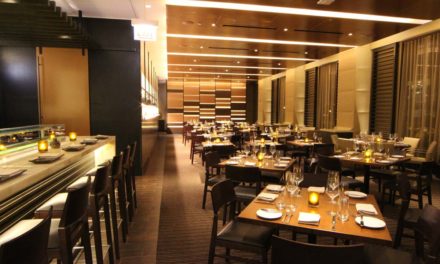The historic quarter in Cordoba, Spain has a remarkable history of cultures that settled here during Roman, Muslim and Christian eras, including a thriving Jewish community between the 10th and 12th centuries. And much of the architecture from these eras still remains, allowing visitors to experience that past.
Your base? Cordoba’s Jewish quarter. It’s a network of lively squares and narrow streets that are barely wide enough for a single car in some places. However, the upside is that these buildings create shadows from the sun’s rays to reduce its impact during the summer months.
Many people travel to Cordoba as a day trip from a meeting or convention based in Sevilla (the closest airport) or Granada. This is the “triangle” that comprises Andalusia. It only takes about 75 minutes by car (recommendation for private car service: Lukman Sea) or just 15 minutes to Cordoba from Sevilla by taking the AVE (Spain’s high speed train). It’s also about 1 hour and 45 minutes between Madrid and Cordoba on the AVE.
 But the truth is, with more than a million visitors annually, Cordoba is actually an appealing destination on its own. The greatest number of visitors come from France, Germany, Italy, UK, USA and Japan, according to data from the Cordoba Tourist Board. And though most people visit Cordoba for leisure reasons, meeting planners are also beginning to discover it. In 2010, there were actually 76 conventions and meetings held in Cordoba, directly bringing more than 16,000 business travelers.
But the truth is, with more than a million visitors annually, Cordoba is actually an appealing destination on its own. The greatest number of visitors come from France, Germany, Italy, UK, USA and Japan, according to data from the Cordoba Tourist Board. And though most people visit Cordoba for leisure reasons, meeting planners are also beginning to discover it. In 2010, there were actually 76 conventions and meetings held in Cordoba, directly bringing more than 16,000 business travelers.
Perhaps you’re staying at the Parador de Cordoba in the city or elsewhere for a meeting or congress. If you find some time to explore the historic quarter on your own or wish to extend your business travel for a day, consider the following travel tips for 24 hours in Cordoba, Spain.
The Mezquita de Cordoba
The Mezquita de Cordoba (also known as the Cathedral-Mosque) is one stop that everyone includes on a visit to Cordoba, and it is really worth the time to take the guided tour. It includes a short film that explains how this mosque evolved and was extended over the centuries as well as access to the Mosque. Cathedral. Inside you’ll see rows of columns and Moorish horseshoe arches from the mosque contrasted with the Christian cathedral and its Baroque alterpiece and mahogany choir stalls. This contrast of styles occurred during nine years of its construction. The courtyard is filled with orange trees that lead to the complex.
Medina Azahara
Located a short drive outside of the Cordoba, consider a visit to the ruins of Medinat al-Zahara, built to serve as an independent western Caliphate during the Moorish rule after 929 A.D. (Caliphate of Cordoba). The city was impressive, built on a mountain and a surrounded by a wall. It had three terraces and served as the home of the Royal Castle of the Caliph Abd-al Rahman III. When you arrive, make sure you view the animated movie in the visitor center that explains the palace city so that it brings your tour of the archaeological site to life. Your guide will provide highlights and explain how the city was structured to include the palace, gardens, residential buildings and the main mosque. The site was destroyed in a civil war at the turn of the 11th century. (Allow yourself about 3 hours in total for this activity).
Tour (and shop) Jewish Quarter in Cordoba, Spain
The best way to get to know the monuments, museums, churches, statues, streets and squares in Cordoba’s historic quarter – as well as Medina Azahara – is through the eyes of a professional guide. The Cordoba Tourism Consortium offers several different options, and they know the best way to structure your visits to ensure the most effective use of your time based on venue schedules. Our guide Juan put this city’s history in both modern and historic perspectives. Highlights included the old Synagogue, Casa Safarad, statue of Maimonides, Chapel of San Bartolome, Archaeological Museum, and Alcazar de los Reyes Cristanos, among others. Although tour lengths can vary, try to plan enough time to enjoy a three hour tour. You’ll find plenty of shopping where you will want to briefly stop or return later.
Casa de Sefarad
Located in the heart of Cordoba’s Jewish quarter, Casa de Sefarad is opposite of the old Synagogue of Cordoba. This house dates back to the 14th century, and is remarkably well preserved. Here, you’ll find five exhibition rooms that contain a range of Sephardic artifacts, and there’s a beautiful patio located in the middle of the house. They also have a library that specializes in Sephardic literature and music. Casa de Sefarad serves as the Jewish cultural center for Cordoba which includes everything from educational seminars for the community and school children to Sephardic music workshops. Casa de Sefarad is a private initiative, so there is a modest entry fee.
Dining in Cordoba, Spain
Olive oil, wine, beef and pork are local to this region. But menus are also filled with local uncommon meats such as venison, wild boar, mouflon, roe deer, rabbit and partridge, to name but a few. Seafood is brought in from the Mediterranean. The cuisine of Cordoba is influenced by Mediterranean, Arab (use of dried fruits, vegetables, sweet and sour flavors, and cakes) and Jewish culinary traditions. Cordoba is filled with restaurants (more than 250) and bars, and the following can be found in Cordoba’s historic quarter:
- Casa Mazal. Located in the Jewish quarter, Casa Mazal is a Sephardic restaurant, so there’s no need to special order anything in advance. For a Cordoban Sephardic experience, try the eggplant hummus, Salonica salad, lamb marinated in spices, and Sephardic marzipan with cinnamon ice cream. Casa Mazal is an intimate space that incorporates cultural elements, including live music and occasional exhibits from local artists.
- Restaurante Bandolero. This restaurant is located in front of the Mosque-Cathedral, and is a 16th century palatial house. They offer seven dining rooms and two outdoor courtyards (great for group events). Restaurante Bandolero has a great wine selection and the Iberican ham is probably among the best I’ve tasted. a wide range of options. The Iberica ham was probably the best I’ve tasted. They also prepare special menus on request (Kosher, Halal and other cuisines).
- Puerta de Sevilla. For a traditional Cordoban restaurant that’s friendly and relaxed, Puerta Sevilla is located in the Old Fortress district of the historic quarter (easy walk). The building is 200 years old offer . The restaurant has two floors, but the patio central area is filled with plants and the atmosphere is inviting and enjoyable for lunch or dinner.
Cordoba, Spain at Night
In Spain, the cities come alive at night, and dinner does not usually begin until after 9 p.m. (locals begin to eat even later). And there are several options to fill your evening. Before dinner, it may be worth a visit to the Arabic Baths of Santa Maria to experience its pools and a massage (travel expert Jackie Sheckler Finch says she enjoyed this Cordoba highlight). If it’s Cordoba nightlife that you want to find, head into the city and enjoy Cafe Sojo (pronounced “Soho”). This is a restaurant by day and turns into one of Cordoba’s livelier nightclubs – opened late. Or, for a quieter evening – outdoors in the historic quarter – stroll over to the Castle of the Christian Monarchs for a short light show (animated for younger visitors), followed by a water, light and sound show (total combined time is about an hour). There’s also an equestrian show, flamenco, theater, walking tours and more.
Hotels in Cordoba, Spain
Hotel Las Casas de la Judería is perfectly located in the Jewish quarter so that it is a matter of steps to the shopping and sites that you want to see. Las Casas de la Juderia is a 64 room, four star hotel where I stayed. You’ll definitely feel like you’re staying at a resort (also great for private business events). The hotel is a collection of several former homes that are washed in white as expected from Cordoban style. Its courtyards are colorful and landscaped, reflecting Jewish, Christian and Jewish symbols. The hotel is filled with original and period furnishings and decorative art, including the works of Cordoban, ancient leather craftsmanship. Not too long ago the hotel began excavations to add its own spa, but in the process discovered that it is actually built above some old arabic baths in that space (which you can viewed). Given the importance of maintaining that history, Las Casas de la Juderia chose to maintain the archaeological finds instead. But there is a small, but terrific pool. Cordoba has 47 hotels throughout the city and surrounding area (more than 5,000 beds), and even more if you count guest houses and other places to stay.
Of course, many of these ideas in Cordoba may also be helpful for meeting professionals who may be planning business events as well.Cordoba was declared a World Heritage site by UNESCO in 1984. Cordoba is part of Caminos de Sefarad, a network of 23 Spanish Jewish Quarters focused on fostering quality cultural tourism based on the Sephardic legacy.
Updated. Initially published October 3, 2011.














